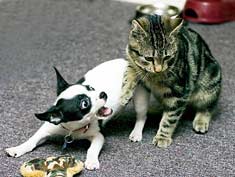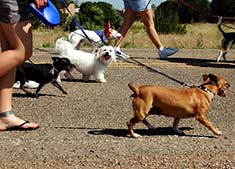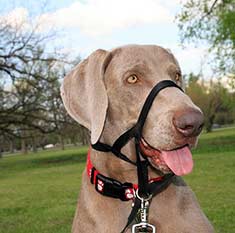Fighting Dogs

If you've been around more than one dog for a long period of time, chances are you've seen your share of dog fighting. No, we're not talking about those dogs who are specifically bred and trained to fight by the Michael Vicks of the world, but rather the every-day dog who occasionally can't control himself and starts a fight with his brother or any other dog who might be in the vicinity.
Why do dogs fight?
Dogs subscribe to the toddler's theory of possession:
- If I like it, it's mine.
- If I can take it from you, it's mine.
- If I had it awhile ago, it's mine.
- If it looks like mine, it's mine.
- If I saw it first, it's mine.
- If you put it down, it's mine.
- If it's near my parents, it's mine.
- If it's food, it's definitely mine!
With all of this selfishness, it's no wonder that dogs sometimes get into battles over possessions, as well as other issues. This is worse in dogs than in our human children because the whole issue is drawn up in the quest for dominance. Going back to a dog's ancestors, only the wolves who were the most dominant were able to survive and to pass on their genes to their offspring.

As Darwin observed, survival was a right bestowed only on the fittest members of the pack. Although our dogs now live in the relative safety and security of a warm home with food and water provided for them, the ancient instinct still rears its ugly head now and again.
Any dog, particularly one who sees himself as the leader of the pack, will challenge anyone who tries to take that leadership role away from him. He sees it as his birthright to eat first, get attention first, mate first, and have first choice as to sleeping arrangements.
Dogs who are lower on the totem pole, conversely, may be continually looking for new ways to challenge the alpha dog, and may instigate many fights in the belief that eventually the senior dog will be defeated.
Not all dogs seem to be driven by pack mentality - why do they fight?
Some dog breeds are simply more aggressive than others. Dogs who are valued as guards are specifically selected for their aggressive nature. When a litter of puppies is born, each one is evaluated as to his aggressiveness. Those who most suit the breeder's idea of how the breed should behave are kept in the breeding pool, while those who are seen as too docile are generally sold as pets. The ones that are kept are then trained to bring out their aggressive natures.
The converse is also true, people who don't intend to have aggressive dogs, but who are unable or unwilling to provide the proper training and socialization experiences for their pets, will likely end up with dogs who are more aggressive than others. Most dogs will naturally respond to fear by becoming aggressive, thinking that if they can scare whatever is threatening them, it will leave, thus relieving their own fear.
How do I stop my dog from fighting?
The best way to stop a dog from fighting is to prevent him from becoming aggressive in the first place. It is vital to take dogs into as many different situations as possible while they are still young enough not to cause any real harm to anyone.

Puppies should go everywhere you go while they are still small. They should be exposed to loud noises, children, crowds, other dogs, and any other situations they are likely to encounter. This early exposure, coupled with your reassurance and praise may keep your dog from panicking when he encounters similar situations once he has reached maturity.
The next most important thing to do with your dog is to train him so that he is under your control at all times. You have a responsibility to keep your dog, as well as the children and other dogs in the neighborhood, safe. You cannot do this if you cannot control your dog.
Ideally, training should start when your dog is no older than six months, however it is never too late to start. The old axiom about teaching old dogs new tricks is not true! In fact, most of Michael Vick's fighting dogs were quickly rehabilitated and placed in adoptive homes.
With the proper motivation, your dog will be happy to learn anything you want him to. The advantage to starting early is that your dog, no matter how big he will eventually be, is still small enough for you to exert physical control over him and show him what is expected.
All behavior has a purpose. If your dog is getting something in return for fighting, he will continue to do so. This means that if your dog is fighting in order to gain your attention, you must give him absolutely NO attention (other than breaking up the fight). If he is fighting to get a toy, you should try to make sure that he doesn't get it, although you should never put yourself into the middle of a dog fight.
How do I break up a dog fight?
One of the easiest and safest ways to break up two dogs who are fighting is to squirt water at them. This doesn't have to be from a fire hose; most dogs can be redirected using a simple squirt bottle. They don't like the sensation of the stream of water hitting them, and it distracts them from their original purpose.
If the spray bottle doesn't work, you may need to seek help from another person. Each of you should grasp one of the two dogs' hind legs and pull them backwards, away from each other, as if you were in a wheelbarrow race.
Once the dogs are apart, it is important that they not be allowed to face each other again until they are totally calm. Assuming the dogs are well-trained in obedience (as all dogs should be) put the dogs in a down position, parallel to each other. As long as neither is able to establish a superior position such as being above the other one or facing off, neither one should feel challenged.
How do I teach my dog that fighting isn't allowed?
Put both dogs in a sit or down position next to each other, again making sure they are not facing or challenging each other. Praise the dogs for being near each other without fighting. Next, give one of the dogs some attention, and praise the other dog if he remains still without becoming jealous. Do the same thing again, but give the second dog attention first. When both dogs are able to tolerate the other dog's getting attention, up the ante by giving one dog a treat, then rewarding the other dog for not getting jealous and starting a fight.
Frequently review the commands of sit, stay, and down with your dogs so you can head off any fights before they even begin, if you see one dog beginning to challenge the other. When you "catch" your dogs playing well with each other, don't forget to praise them, and maybe even give them a treat.

What if I need extra help?
Don't be afraid to muzzle your dog if it's required to keep everyone safe. The muzzle might bug him a little, but it won't actually hurt him. Just make sure he can drink through the muzzle.
If you need extra help, consider consulting a dog trainer or behavioralist. He may be able to point out some things you are doing or not doing that may be triggering your dog to react aggressively. For example, some dogs have been known to become overly protective of the female head of household when she becomes pregnant. You may simply need to have your husband walk the dog until you deliver.
Similarly, there may be things in your home that are setting off your dog. If you have recently made changes, such as bringing home a new baby, a dog trainer may have some suggestions for you that will make your dog happier about his newly demoted status.
Doggies Den: Latest Articles
 Homemade Thanksgiving Treats for Your Dog
Homemade Thanksgiving Treats for Your Dog
NUTRITION We all want to include our dogs in our holiday celebrations, but hopefully, you're aware that sharing table scraps with your dog isn't always the best idea.
 Keeping Your Dog Safe during the Summer Months
Keeping Your Dog Safe during the Summer Months
HEALTH Summer is coming on fast, so it’s time to plan how you will keep your dog safe and healthy through the lazy, carefree, warm days.
 Vaccination Time Again-Keeping Your Puppy Healthy
Vaccination Time Again-Keeping Your Puppy Healthy
DOG HEALTH So you have your new puppy picked out. There are quite a few shots, treatments and examinations that will keep the newest member of your family healthy.
 Canine Thanksgiving Feast
Canine Thanksgiving Feast
NUTRITION With the wide variety of food at Thanksgiving dinner, chances are you'll want to give your dog something special, too. If you're contemplating what to feed your dog for the holiday, here is a guide to a great Canine Thanksgiving Feast.
 Dog Walking Tips Every Owner Should Know
Dog Walking Tips Every Owner Should Know
DOG FUN Walking your dog is not only crucial to keeping him healthy and happy, it strengthens the bond between your canine friend and his caregiver. There are a lot of obstacles out there. Don’t forget these simple tips to keep your walk fun and safe in the outside world.
 The Benefits of Physiotherapy for your Dog
The Benefits of Physiotherapy for your Dog
HEALTH The same techniques that physiotherapists use to treat a variety of injuries and conditions in humans have been adapted to suit animals with great success. Family pets, show dogs, and working dogs can all benefit greatly from physiotherapy. Dogs whose activities involve a lot of agility are especially susceptible to the types of problems that physiotherapy can address.
 The Decision- Adding a Dog to Your Family
The Decision- Adding a Dog to Your Family
FIRST TIME OWNERSBringing a dog into your family is a decision where many people don’t realize it’s magnitude until after they have the dog. There are a number of things that you need to research before you decide to purchase a dog, and it starts right in your own home.
 Bringing Your Dog Into Your New Baby's Life
Bringing Your Dog Into Your New Baby's Life
HEALTH Many believe that a dog and a new baby cannot happily coexist, so therefore the dog has to go. This is not necessarily the case.  A new baby does not mean you have to abandon your dog.

Doggies Den:
Most Popular Articles

Dog Pregnancy Symptoms
HEALTHIf you suspect your dog might be pregnant, check out part one in this series on pregnant dogs, where we cover pregnant dog symptoms.

Dog Birth
HEALTHIn the third article of our dog pregnancy series, we look at the wonderful, but messy, process of bringing newborn puppies into the world.

Indoor Dog Potties
DOG PRODUCTSIt's been a long day at work. You were so busy, you didn't even take time to eat a sandwich, let alone run home to let your dog out. You're on your way home, knowing the poor dog is crossing his or her legs by now, when your car breaks down, delaying you even further. Can't somebody make this easier?

Your Dog’s Digestive System
PHYSIOLOGYEver wonder why your dog eats so fast? Or why he eats gross things? Or why he gets sick to his stomach? Or why his waste stinks so bad? Some of these things are normal, some are not.

Canine Respiratory System
BREATHINGThe basic function of your dog's respiratory system is to bring oxygen in to and remove carbon dioxide from the body. Knowing the symptoms of respiratory diseases can help you help your stay healthy.

Shelter Dog Adoption Tips for Success
ADOPTION Are you intimidated by the prospect of "rescuing" a dog from a shelter? One reason that you may be wary of adopting a dog from a shelter is not knowing how to choose. Adopting a dog from a shelter can be a rewarding process, if you're prepared to do a reasonable amount of research.

Canine Urinary Tract Infections
SYMPTOMS AND TREATMENTDoes your dog seem to be having trouble relieving his or her bladder? Learn how to recognize the signs of urinary tract infections and how to treat them before they spread.

What to do for Dog Diarrhea
SYMPTOMS AND REMEDIESIf you have dogs in your house for any length of time, you have likely experienced at least one bout of dog diarrhea. Beyond the pain in the tuckus involved in cleaning up the mess, you should know what causes diarrhea, and when it's important to see the vet.

What to do for a Dog Bite
DOG BEHAVIOR Getting bitten by a dog can be scary, and you may be tempted to run around in circles for a while, trying to figure out what to do. Here's our guide to help you manage the situation.

Top Ten Tips for Living with a Senior Dog
DOG HEALTH Bringing home a new puppy is so exciting, but it doesn’t take all that long for your exuberant puppy to grow into a senior dog who may have special needs. Here are the doggies.com top ten tips for taking care of your companion who has been with you through so much.
